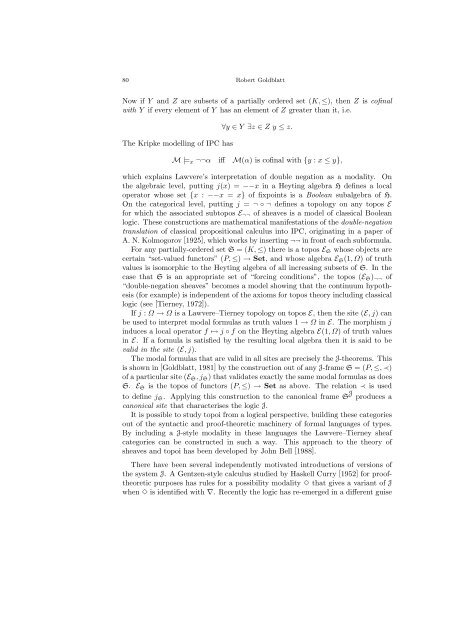MATHEMATICAL MODAL LOGIC: A VIEW OF ITS EVOLUTION
MATHEMATICAL MODAL LOGIC: A VIEW OF ITS EVOLUTION
MATHEMATICAL MODAL LOGIC: A VIEW OF ITS EVOLUTION
Create successful ePaper yourself
Turn your PDF publications into a flip-book with our unique Google optimized e-Paper software.
80 Robert GoldblattNow if Y and Z are subsets of a partially ordered set (K, ≤), then Z is cofinalwith Y if every element of Y has an element of Z greater than it, i.e.The Kripke modelling of IPC has∀y ∈ Y ∃z ∈ Z y ≤ z.M |= x ¬¬α iff M(α) is cofinal with {y : x ≤ y},which explains Lawvere’s interpretation of double negation as a modality. Onthe algebraic level, putting j(x) = −−x in a Heyting algebra H defines a localoperator whose set {x : −−x = x} of fixpoints is a Boolean subalgebra of H.On the categorical level, putting j = ¬ ◦ ¬ defines a topology on any topos Efor which the associated subtopos E ¬¬ of sheaves is a model of classical Booleanlogic. These constructions are mathematical manifestations of the double-negationtranslation of classical propositional calculus into IPC, originating in a paper ofA. N. Kolmogorov [1925], which works by inserting ¬¬ in front of each subformula.For any partially-ordered set S = (K, ≤) there is a topos E S whose objects arecertain “set-valued functors” (P, ≤) → Set, and whose algebra E S (1, Ω) of truthvalues is isomorphic to the Heyting algebra of all increasing subsets of S. In thecase that S is an appropriate set of “forcing conditions”, the topos (E S ) ¬¬ of“double-negation sheaves” becomes a model showing that the continuum hypothesis(for example) is independent of the axioms for topos theory including classicallogic (see [Tierney, 1972]).If j : Ω → Ω is a Lawvere–Tierney topology on topos E, then the site (E, j) canbe used to interpret modal formulas as truth values 1 → Ω in E. The morphism jinduces a local operator f ↦→ j ◦ f on the Heyting algebra E(1, Ω) of truth valuesin E. If a formula is satisfied by the resulting local algebra then it is said to bevalid in the site (E, j).The modal formulas that are valid in all sites are precisely the J-theorems. Thisis shown in [Goldblatt, 1981] by the construction out of any J-frame S = (P, ≤, ≺)of a particular site (E S , j S ) that validates exactly the same modal formulas as doesS. E S is the topos of functors (P, ≤) → Set as above. The relation ≺ is usedto define j S . Applying this construction to the canonical frame S J produces acanonical site that characterises the logic J.It is possible to study topoi from a logical perspective, building these categoriesout of the syntactic and proof-theoretic machinery of formal languages of types.By including a J-style modality in these languages the Lawvere–Tierney sheafcategories can be constructed in such a way. This approach to the theory ofsheaves and topoi has been developed by John Bell [1988].There have been several independently motivated introductions of versions ofthe system J. A Gentzen-style calculus studied by Haskell Curry [1952] for prooftheoreticpurposes has rules for a possibility modality ✸ that gives a variant of Jwhen ✸ is identified with ∇. Recently the logic has re-emerged in a different guise
















